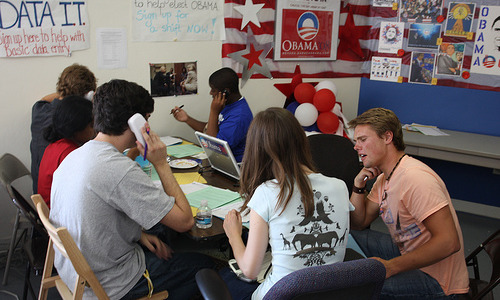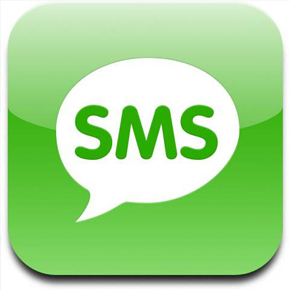
GOTV mobilization is a challenge for any campaign. How a campaign allocates its resources in this late, crucial stage of the campaign can make the difference between winning and losing. Should we hit the field with another mail piece or do another ad buy? How about paid canvass? What will my call universe look like? There are so many considerations that it can be a challenge to get the correct mix of ingredients. A recent study—
“Don’t Forget to Vote: Text Message Reminders as a Mobilization Tool”—show the effectiveness of the medium. During the study, authored by
Allison Dale of the
University of Michigan and Aaron Strauss of
Princeton University, texting was used in a nationwide field experiment in the days before the 2006 election. Newly registered and re-registered voters in the treatment group received a text message encouraging them to vote; participants in the control group did not receive a text. Those receiving the text reminders voted at a 3.1 percent higher rate than those who did not. So why is text messaging so effective? In the age of mass communication, citizens are inundated with political and commercial information through landline phones, U.S. mail, email, and television, which leads recipients to increasingly ignore messages delivered through these media. Because it is time consuming to process, people tend to ignore a majority of unsolicited information that comes their way. For a political message to be effective, it must break through the barrage of messages competing for the voter’s attention. Studies show that one political mainstay—direct mail pieces—have become less effective over time because of an ever-increasing volume of mail sent out in each new election. In fact, these studies suggest that a single piece of mail only increases voter turnout by 1 percent or less.

In contrast to direct mail and other media, text messages are more difficult for recipients to ignore. The recipient will notice the text message because mobile phones are still relatively uncluttered by “spam” messages. Similarly, the nature of the display makes it difficult to ignore an incoming text message on most phones.
Text messaging is particularly effective in GOTV mobilization because of one simple fact: the audience is already “sold.” By registering to vote, recipients have already signaled their interest in voting. Your text will increase the likelihood of voting because it reminds a person to complete a “civic duty” that he or she already believes is important. The effectiveness of
mobilization reminder texts can be likened to reminding a person to the oil changed in his or her car. Once a person has decided to purchase a car, he or she has made an investment in owning, and also maintaining, the car. Car owners don’t need to be convinced of the importance of getting an oil change; they just need to be reminded to get it done. Like an oil change, voting is an activity that needs to be put on the “to do” list. Voting is not part of one’s daily routine, even for experienced voters; reminders help ensure that potential voters do not forget to visit their polling places. Relative to other strategies, the study shows that text messaging registered the largest increase in voter turnout. The only medium that resulted in an equivalent increase in voter turnout was door-to-door canvassing. Canvassing is more effective than text messaging on a person-by-person basis. However, the contact rate during the canvassing is much lower than text messaging; people aren’t home, they don’t answer their door, or perhaps they’ve moved. One text message reminder to voters is twice as effective as three direct mail pieces. When you combine the relative low cost of SMS text messaging, with its proven effectiveness, it becomes crystal clear that text messaging is an essential component of any voter mobilization effort.
 GOTV mobilization is a challenge for any campaign. How a campaign allocates its resources in this late, crucial stage of the campaign can make the difference between winning and losing. Should we hit the field with another mail piece or do another ad buy? How about paid canvass? What will my call universe look like? There are so many considerations that it can be a challenge to get the correct mix of ingredients. A recent study—“Don’t Forget to Vote: Text Message Reminders as a Mobilization Tool”—show the effectiveness of the medium. During the study, authored by Allison Dale of the University of Michigan and Aaron Strauss of Princeton University, texting was used in a nationwide field experiment in the days before the 2006 election. Newly registered and re-registered voters in the treatment group received a text message encouraging them to vote; participants in the control group did not receive a text. Those receiving the text reminders voted at a 3.1 percent higher rate than those who did not. So why is text messaging so effective? In the age of mass communication, citizens are inundated with political and commercial information through landline phones, U.S. mail, email, and television, which leads recipients to increasingly ignore messages delivered through these media. Because it is time consuming to process, people tend to ignore a majority of unsolicited information that comes their way. For a political message to be effective, it must break through the barrage of messages competing for the voter’s attention. Studies show that one political mainstay—direct mail pieces—have become less effective over time because of an ever-increasing volume of mail sent out in each new election. In fact, these studies suggest that a single piece of mail only increases voter turnout by 1 percent or less.
GOTV mobilization is a challenge for any campaign. How a campaign allocates its resources in this late, crucial stage of the campaign can make the difference between winning and losing. Should we hit the field with another mail piece or do another ad buy? How about paid canvass? What will my call universe look like? There are so many considerations that it can be a challenge to get the correct mix of ingredients. A recent study—“Don’t Forget to Vote: Text Message Reminders as a Mobilization Tool”—show the effectiveness of the medium. During the study, authored by Allison Dale of the University of Michigan and Aaron Strauss of Princeton University, texting was used in a nationwide field experiment in the days before the 2006 election. Newly registered and re-registered voters in the treatment group received a text message encouraging them to vote; participants in the control group did not receive a text. Those receiving the text reminders voted at a 3.1 percent higher rate than those who did not. So why is text messaging so effective? In the age of mass communication, citizens are inundated with political and commercial information through landline phones, U.S. mail, email, and television, which leads recipients to increasingly ignore messages delivered through these media. Because it is time consuming to process, people tend to ignore a majority of unsolicited information that comes their way. For a political message to be effective, it must break through the barrage of messages competing for the voter’s attention. Studies show that one political mainstay—direct mail pieces—have become less effective over time because of an ever-increasing volume of mail sent out in each new election. In fact, these studies suggest that a single piece of mail only increases voter turnout by 1 percent or less. 